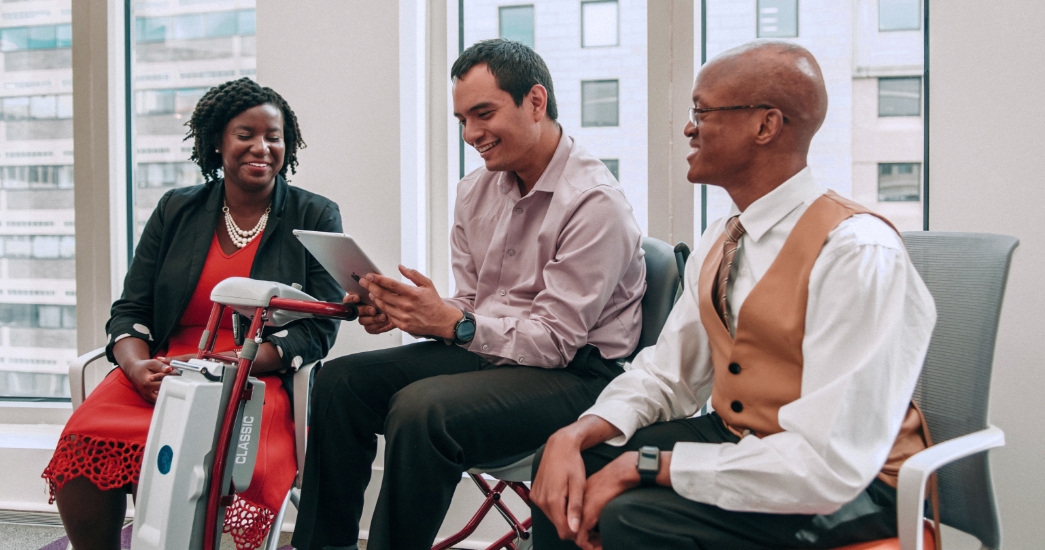

In the U.S., one in four adults have some type of disability, with mobility and cognition being the most common. Disability isn’t always apparent, and stigmas can often keep those who live with an unnoticeable disability from sharing it openly with employers. But for many reasons, fostering a workplace that invites conversation about disability and accessibility, and is inclusive for people of different abilities, makes the workplace better for all of us.
Here we’ll explore the ways in which people with disabilities are a very important piece of the puzzle to improve the workplace experience, and how employers can make their organizations and cultures more inclusive for all levels of ability.
![]()
By designing with a particular disability in mind, organizations aren’t just accommodating a person with a disability, they’re creating better experiences for everyone, according to Sarah Pashe, Lead Diversity, Equity, Inclusion and Accessibility Specialist: accessibility and communications of Point32Health, the parent company of Harvard Pilgrim Health Care and Tufts Health Plan. Pashe gives the example of a ramp into a building, “Yes, ramps are essential for somebody like me who uses a wheelchair. They’re also great for people who might be rolling a suitcase behind them, or have a lot in their arms, have a temporary medical condition or perhaps they’re bringing in a baby stroller…” Another example she raises is captions. Studies have shown that videos with captions, which are helpful for people who may identify as Deaf or hard of hearing, actually improve attention, comprehension and retention of information for all users.
![]()
Employees with disabilities bring with them grit, diverse competencies, skills and different perspectives and experiences. This is key when it comes to creating resilient and innovative workplaces. “Because we inherently live in a world that might not be designed for us,” Pashe explains, “people with disabilities have strengths like adaptability, patience, creativity and/or innovation.” People with disabilities bring unique perspectives that lead to better products, solutions and outcomes, making them an asset to the teams and organizations they’re a part of. Studies even show that employees with disabilities contribute to higher productivity, lower absenteeism and increased customer loyalty, as well as reduced turnover.
![]()
Where do you begin when trying to create a more inclusive environment for people with disabilities? Benchmarking is a great place to start. “Understand [your organization’s] current state, figure out what kind of foundation you have and then build on that,” Pashe says. One way to do this is with the Disability Equality Index assessment tool, which is used by companies like Point32Health to measure things like culture and leadership, enterprise-wide access and employment practices to help identify actions to continue to advance accessibility and disability inclusion. Research from Disability:IN shows that companies that use this tool improve their scores and, over time, had 28% higher revenue and two times higher net income than other companies.
![]()
When it comes to creating an inclusive workplace culture for people with disabilities, an organization’s health benefits play a significant role. Pashe notes that there can be a lot of benefits information out there, so communication is key. Having a comprehensive benefits offering and making sure employees know what resources and programs are available to them can be tremendously helpful to people as they navigate the health care system’s complexities. And because some chronic health conditions can be considered a disability, programs like Harvard Pilgrim’s care manager program are one way for employees to get personalized guidance when it comes to understanding care options, creating a plan and coordinating and implementing care services.
![]()
Language matters when it comes to creating a disability inclusive culture. “Sometimes, we can talk about disability in a way that can unintentionally put up some barriers between the disability community and those who don’t currently have [a disability],” notes Pashe. The National Center on Disability Journalism offers a language guide about disability awareness and how to use empowering instead of disempowering language in communications. Pashe adds that when it comes to talking about their disability, some people prefer identity-first language, whereas others prefer person-first language. For example, some may prefer, I am a disabled person (identity-first), while others may prefer, I am a person with a disability (person-first). Inclusion tip: Use person-first language until you’re informed otherwise. Checking in with the individual on their personal preference is also a respectful approach.
Employees with disabilities offer diverse and unique perspectives, share innovative ideas and help to make organizations better, sought-after places to work. Employers can improve the workplace experience by continuing to advance inclusion in partnership with people with disabilities and communicating often about benefits offerings to help everyone feel informed, included and valued.